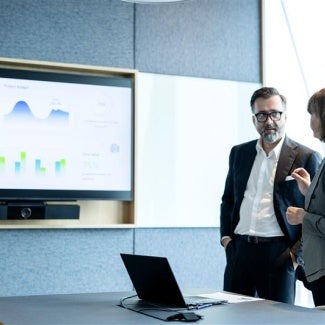Planning for change
Integrating climate adaptation planning and resilience measures into your firm’s design process helps to ensure overall project success, particularly in a rapidly changing environment.

Integrating Resilience Measures
As the climate changes, the environmental factors impacting our buildings are becoming stronger, outpacing adaptation efforts. A big part of climate action is adaptation planning—making design decisions that allow adjustments to new patterns over time in addition to the costly weather-related events exacerbated by an already changing climate. Adaptation measures do not prevent climate impacts, but they do mitigate risks to people and the built environment. Firms that plan ahead to reduce negative impacts and take advantage of emerging opportunities will be better prepared to meet changing design conditions; their projects are likely to have an extended service life and minimal repairs after hazard events, avoiding additional embodied carbon consumption.
Adaptation planning is a highly iterative learning process that recognizes risk and the role of failure and consequence in preparing for a more resilient future. The process outlines the optimal future conditions and the relationships between them, "backcasting" in order to systematically lay out the steps necessary to achieve the desired results.
The architect’s role is to envision transformation in the built environment and plan how to adapt to dynamic shifts that are the result of climate change. Develop a firmwide approach to design projects to keep pace with climate change. AIA’s Fundamentals of Resilient and Climate-Adaptive Design describes eight foundational principles of design: Place-based, risk-prepared, equitable, precautionary, system-centric, ready, service life–focused, and adaptive.
Steps toward adaptation:
- The first step in adaptation planning is understanding the risks. However, much of the information architects rely on is based on historic risks rather than present vulnerability or potential future impacts (e.g, use of Flood Insurance Rate Maps to establish flood insurance premiums). In the areas where you work, maintain reliable projections on future climate change impacts, and document changes that are already being experienced in order to understand the magnitude of the climate problem.
- The second step is assessment. Identify and prioritize investments to mitigate risks from anticipated climate change-induced hazards and focus on actions that reduce vulnerability to the events we are more certain about. Resilience to all hazards against all impacts is an impossible goal for buildings. Evaluate the effects that impact buildings and communities where you work. The perception of risk is often subjective, so being able to point to specific examples of hazard events that exceeded the design basis, or projects that rebounded quickly after what could have caused substantial damage, helps clients and stakeholders recognize the impacts depicted by science.
- The third step is to design for the impacts that are expected over the life of the building. Identify the systems that may become vulnerable in your climate zone, and consider how buildings might adapt, relocate, or be decommissioned when conditions warrant changes in access, use, or operation of the building. In every project, consider measures that promote passive survivability: Continuous operations during and after a climate event, natural ventilation, on-site renewable energy to power essential loads, and other options.
- The fourth step is to evaluate adaptation efforts regularly. Evaluate whether conditions have changed and check whether assumptions remain valid. Calibrate your expectations about climate with observed and anticipated events. Both the built environment and the climate are in a state of constant change, so areas for development may shift and incentives may arise. Sometimes even a disaster creates the opportunity to effect change. Measure progress across your portfolio and recognize that there is not a clear endpoint to adaptation.
Design for flexibility
Design projects to accommodate change. Propose building systems that can be easily moved, reconfigured, or upgraded. Consider unprogrammed space that can serve a variety of functions over time. Design for long life and loose fit. Design to simplify reconfiguration without creating waste. Propose a structural design that can better withstand environmental stressors over time. Planning for potential changes reduces the cost of future modifications; AIA’s Building’s That Last: Design for Adaptability, Deconstruction, and Reuse highlights benefits and examples as well as pitfalls to watch out for.
Clients may not be prepared to undertake climate adaptation measures as part of their initial development cost and defer implementing these measures until conditions worsen. For example, flooding may threaten a neighborhood in the coming decades, but initial project funding is limited. Options to accommodate changes might include designing a foundation that can be strengthened when protection is needed or designs with high ground-floor ceilings so that the ground floor can be elevated as sea levels rise over time. Neither of these options would be easy to implement without advance planning.
Design for multiple benefits
Propose solutions that reduce vulnerability and reduce GHG emissions. Solutions that offer immediate benefits and reduce long-term vulnerability will be the most attractive to clients. “Win-win” solutions are activities that enable economic gains while contributing to climate mitigation or adaptation (such as installing solar PV that reduces operating costs and reduces GHG emissions). “No regrets” solutions increase resilience by strengthening people or places, whether or not an anticipated hazard materializes (such as relocating housing away from the floodplain and transforming lots into green space for the community). One example of multiple benefits from a single component is renewable energy, which can decarbonize the grid, provide local jobs to build equity, and maintain building operations after extreme events. Look for opportunities to incorporate these into every project.
Respond to community
Hazards are universal, but impacts are local. Every community has a different threshold for risk, a variety of resources for responding to hazards, divergent views about what risks should be prioritized, and other projects underway. Architects can look for synergies with neighboring developments to support adaptation planning. For example, Climate Ready Boston outlined how the development of new structures near flood-prone areas presented opportunities to construct individual buildings prepared for flood risk but also to raise funds for the construction of community flood defenses.
Maintain awareness of issues in the community that affect vulnerability: The places where hazards hit over and over, areas of disinvestment, and new developments in high-hazard areas. Advocate for long-term planning to address these concerns and consider how your firm will handle projects in sensitive areas.
Develop equitable resilience strategies because people are not uniformly vulnerable to climate change. Adapting to climate change can lead the way toward more equal societies, but achieving this takes intention and planning. Opportunities are available across your portfolio to ensure climate mitigation and adaptation efforts are not concentrated in a single building type or neighborhood, ensuring efforts are focused on environmental justice.
Consider the community resources available to recover from a hazard event: Are there economic, resource, or infrastructure challenges to evaluate ahead of a forecasted hazard event, such as a hurricane? What might it mean for jobs or cultural ties if residents are forced to relocate (even temporarily) after a disaster? How can architects build in protection so that people and structures can shelter safely and recover quickly? Use stakeholder engagement to ensure that people from a wide variety of backgrounds are involved in adaptation planning, as in the Rebuild by Design Competition in New York following Hurricane Sandy.
Consider the worst-case scenario
There are places where climate change will overwhelm local resources and deplete economic capacity; architects can help the client to determine the environmental triggers for relocation or decommissioning so that these resources are not abandoned. Talk about climate change with your clients. Designing the future relocation or decommissioning of a building is a growing area of practice in high-hazard geographies.
The National Park Service includes adaptation options for cultural resources such as buildings: Modifying the structure to better withstand environmental stressors, relocating stationery resources, documenting the resource and allowing the location to be lost, and interpreting the changes wrought by climate as part of its timeline. Architects are integral participants in evaluating these options by elaborating the benefits and drawbacks of different solutions and defining the potential timescale for making decisions.
Resources
- Read National Climate Assessment 2018, Chapter 28: Reducing Risks Through Adaptation Actions to understand current research and projections of adaptation initiatives across the world.
- Explore the Fundamentals of Resilient and Climate-Adaptive Design to learn more about the eight principles to reduce harm and property damage, adapt to evolving conditions, and more readily, effectively, and efficiently recover from adverse events.
- Learn from this practice AIA guide: Buildings That Last: Design for Adaptability, Deconstruction, and Reuse to implement design strategies for buildings and materials that last.
- Use the AIA Resilient Project Process Guide to identify the points in which resilience and climate adaptation goals can be layered into specific design solutions.
Explore more chapters on building an architectural practice that embraces climate change mitigation and adaptation.



